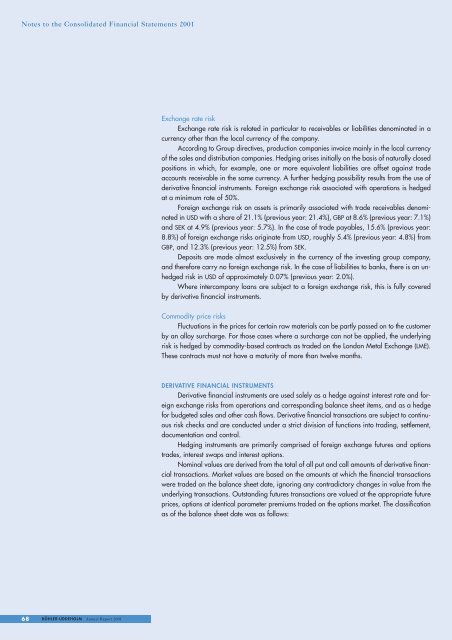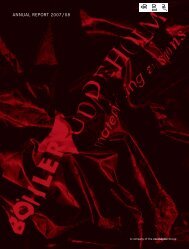Annual Report 2001 - Bohler Uddeholm materializing visions
Annual Report 2001 - Bohler Uddeholm materializing visions
Annual Report 2001 - Bohler Uddeholm materializing visions
Create successful ePaper yourself
Turn your PDF publications into a flip-book with our unique Google optimized e-Paper software.
Notes to the Consolidated Financial Statements <strong>2001</strong><br />
68 BÖHLER-UDDEHOLM <strong>Annual</strong> <strong>Report</strong> <strong>2001</strong><br />
Exchange rate risk<br />
Exchange rate risk is related in particular to receivables or liabilities denominated in a<br />
currency other than the local currency of the company.<br />
According to Group directives, production companies invoice mainly in the local currency<br />
of the sales and distribution companies. Hedging arises initially on the basis of naturally closed<br />
positions in which, for example, one or more equivalent liabilities are offset against trade<br />
accounts receivable in the same currency. A further hedging possibility results from the use of<br />
derivative financial instruments. Foreign exchange risk associated with operations is hedged<br />
at a minimum rate of 50%.<br />
Foreign exchange risk on assets is primarily associated with trade receivables denominated<br />
in USD with a share of 21.1% (previous year: 21.4%), GBP at 8.6% (previous year: 7.1%)<br />
and SEK at 4.9% (previous year: 5.7%). In the case of trade payables, 15.6% (previous year:<br />
8.8%) of foreign exchange risks originate from USD, roughly 5.4% (previous year: 4.8%) from<br />
GBP, and 12.3% (previous year: 12.5%) from SEK.<br />
Deposits are made almost exclusively in the currency of the investing group company,<br />
and therefore carry no foreign exchange risk. In the case of liabilities to banks, there is an unhedged<br />
risk in USD of approximately 0.07% (previous year: 2.0%).<br />
Where intercompany loans are subject to a foreign exchange risk, this is fully covered<br />
by derivative financial instruments.<br />
Commodity price risks<br />
Fluctuations in the prices for certain raw materials can be partly passed on to the customer<br />
by an alloy surcharge. For those cases where a surcharge can not be applied, the underlying<br />
risk is hedged by commodity-based contracts as traded on the London Metal Exchange (LME).<br />
These contracts must not have a maturity of more than twelve months.<br />
DERIVATIVE FINANCIAL INSTRUMENTS<br />
Derivative financial instruments are used solely as a hedge against interest rate and foreign<br />
exchange risks from operations and corresponding balance sheet items, and as a hedge<br />
for budgeted sales and other cash flows. Derivative financial transactions are subject to continuous<br />
risk checks and are conducted under a strict division of functions into trading, settlement,<br />
documentation and control.<br />
Hedging instruments are primarily comprised of foreign exchange futures and options<br />
trades, interest swaps and interest options.<br />
Nominal values are derived from the total of all put and call amounts of derivative financial<br />
transactions. Market values are based on the amounts at which the financial transactions<br />
were traded on the balance sheet date, ignoring any contradictory changes in value from the<br />
underlying transactions. Outstanding futures transactions are valued at the appropriate future<br />
prices, options at identical parameter premiums traded on the options market. The classification<br />
as of the balance sheet date was as follows:




